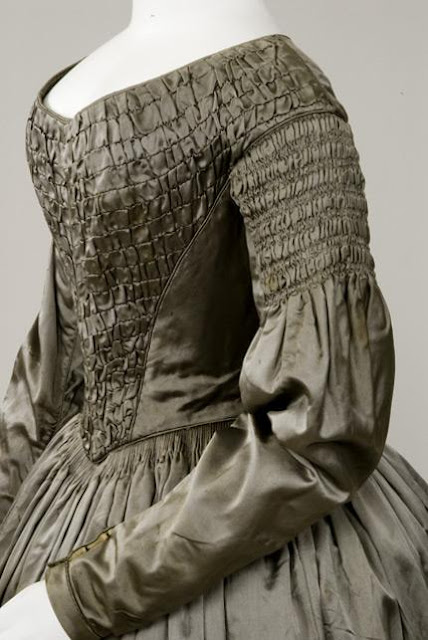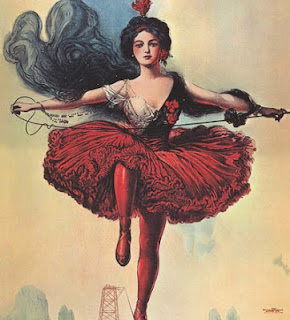Hey!
So I'm finally posting on the Kaprifol Jacket I made for class last semester. This is one of my favorite pieces, which is strange, because I don't normally go for floral prints. I was going through some patterning books for a garment I could whip up easily for my project (I had three other finals, so I didn't want to go too crazy). The
one garment I had come back to time and again, but never made, was the ubiquitous floral
swallow-tail jacket from the Colonial Williamsburg Collection in Costume Close-Up (Baumgarten, 39).
The silhouette is flattering and fun, while the construction is straightforward
and easy to replicate. There is also the added benefit of Linda Baumgarten
documenting the construction steps in her book.
 |
| Swallow-Tail Jacket from Colonial Williamsburg Collection |
I
first wanted to make the garment out of a solid tropical weight wool, as I have
two striped linen petticoats that I use most often, and wanted something I
could use with both. But as I scoured reproduction fabric sites online, I fell
in love with a floral print from Wm. Booth, Draper . This
textile, called “Kaprifol,” is a hand block-printed reproduction cotton from a
jacket lining in the Kallfors Manor Collection in Sweden.
It has the same proportion, fiber content, color palette, and basic shapes as
the Williamsburg jacket. I was blown away by the similarities in the fabrics,
so I decided to do a modified reproduction.
.jpg) |
| "Kaprifol" hand-printed cotton from Wm. Booth, Draper |
After
studying the image of the jacket, I realized that it would be simple to
recreate. The floral pattern of the fabric is the majority of the decoration,
so I didn't have to worry about purchasing and making yards and yards of trim.
There is blue silk box-pleated trim around the bottom of each sleeve, about 1”
wide, but other than that, the fabric and the fit really make the jacket.
There were some changes I made to the jacket, so it
cannot be a faithful reproduction: I made the jacket close edge to edge, as
opposed to it lacing closed over a stomacher, and combined two front bodice
pieces into one. I don’t like the look of visible lacing, so I used another
authentic method of finishing the jacket, and lengthened the center front edges
so that they met with a bit of overlap so I could pin them shut.
The practice of pinning shut a gown or jacket front was
very common among women of the time. Robings and center front trims on gowns
and jackets hid closing pins, as well as providing decoration. It was a simple
way of closing a gown, and allowed the wearer to adjust the way her gown closed
due to weight gain and loss, or pregnancy (What Clothes
Reveal, Baumgarten). I have had experience with weight gain-- or a new
pair of stays that changes my measurements-- ruining the fit of a gown or
jacket. Because this jacket is a garment I want to use for a long time, I made
the center front length overlap enough to make sure that didn't happen.
Fabric and Prep:
I first scaled up the pattern that Baumgarten gives in
her book, and made a mock-up. I wanted to do this before purchasing the fabric,
as I didn't have a yardage guide. The fabric was also on the expensive side ($40.00/yd. Ouch.), so
I wanted to get the smallest yardage I could, and piece pattern pieces together
if I had to. I decided on 1 ½ yards of 52” fabric, enough for the jacket, and a
little left over for some self-trim if I ever decided to change the jacket
decoration.
For the lining, I had some lightweight linen, a little
thinner than the lining in the original jacket, but already in my sewing stash.
For the shoulder straps, I decided to use some heavier weight unbleached linen,
since I ran out of the lighter weight fabric. Using different fabrics for
lining was very common during the time, and was necessary, since fabric was
often sent away for, not purchased at a local fabric store (What Clothes Reveal, 40).
For the sleeve trim, I decided to use a slate blue silk
dupioni that I had in the stash from a previous project. I decided on 1 ½” trim
around the sleeve edge, a little larger than the original, but more
proportionate to my sleeve length. The silk is much lighter than the blue in
the Kaprifol fabric, but has the same tone, and I like the little bit of
contrast. I may replace it with some silk taffeta, since I'm not too sure about the slubbiness of the dupioni I have.
The linen and silk were ready to sew, and I threw the
Kaprifol fabric into the wash with some synthrapol. The cotton was much thicker
than I thought it would be, so I was less worried about the thin linen I was
going to use for the lining. After washing the fabric and sending it through
the dryer to shrink, I ironed it and traced out the pattern onto the Kaprifol
and linen fabric. I used a water-erase pen, which made my life a whole lot
easier. I marked out the pieces, and eyeballed a ¾” seam allowance. For the
center front I measured a 1” seam allowance so the jacket could be let out if
my proportions grew. After cutting, I started to sew the sleeves.
Construction:
18th century construction methods are much
different than ours. Their primary goal was to make clothing modifications easy
in order to reuse the fabric as many times as they could. The seams were
strong, but able to be pulled out quickly if need be (Costume Close-Up, 7-8). This jacket is mainly constructed with
lapped seams, which are strong, and hide the raw edges, but can be easily
snipped out. First, I sewed the sides of the sleeve together, with only one
side of the lining and both edges of the Kaprifol fabric with right sides
together. I sewed small backstitches with bleached linen thread, and left the
bottom ½” unsewn, so I could turn it under for the hem. I pressed the seam
allowance to the edge of the lining that was not sewn. I turned under the seam
allowance of the free lining and laid it over the pressed seam. I used a
slipstitch to sew both sides of the lining together. I repeated the process
with the elbow dart and the second sleeve.
 |
| Sleeves. Done. |
I then turned the raw edges together to form a clean hem
and used a stitch that Baumgarten illustrates, but has no name for. In
dressmaking manuals of the time, the stitch is called le point a rabattre sous la main (Costume Close-Up, 8). This looks like a running stitch from the
outside, but a hemming or slip stitch from the inside. It was actually fun to
do, and I will probably start finishing all of my hems this way.
 |
| le point a rabattre sous la main |
When that was done, I set the sleeves aside and started
on the body of the jacket. The lapped seams are a little different on the body,
as the seam allowance on one side of the Kaprifol fabric is folded down and placed
on top of the other Kaprifol piece and its lining. A backstitch goes through
these three pieces of fabric, leaving about ½” on the top and bottom unsewn so
a clean hem could be made. The loose lining seam allowance is then turned down
and the lining is slipstitched to the lapped lining. Each seam is completed
this way. When done, the hem is turned in and finished with the le point a rabattre sous la main. There
is a slit along the front of the bodice that allows the jacket skirt to flare
out from the body. I cut this and bound it with self-fabric binding cut on the
Straight of Grain. To conserve fabric, 18th century seamstresses and
tailors would cut bindings on the Straight of Grain instead of on the bias (Costume Close-Up, 7).
The
next part is adding the shoulder piece. The shoulder straps need to be snugly
fitted to each individual; since the garment is supported by the torso and
stays, the jacket should not hang by the shoulders (40). Asking someone for
help was out of the question, so I used my duct tape dress form. I made this
while wearing my stays, and it provides the correct shape for fitting the
shoulders and setting the sleeve caps. After fitting the shoulder strap lining to
the bodice front and back, I folded over the raw edges at the neckline and
armscye and pinned them in place.
I then
set in the sleeve on the lower half of the armscye, placing right sides of the
Kaprifol together. In the extant garment interiors that I have seen, including
the Colonial Williamsburg jacket, the seam allowance of the lower half of the
sleeve is left raw (26). Whether this was for the ease of taking out the sleeve
for remodeling, or because this area saw a lot of wear and needed to be mended
often, it is still a mystery to me. I have searched for an explanation of this
practice, but haven’t found anything mentioning the reasons for it. I stopped my backstitches at the
shoulder strap, and pulled the sleeve cap to sit on top of the shoulder strap
lining.
Sleeve
caps were fitted to the individual as well, with the cap fullness pleated
toward the back of the shoulder. The fashionable look was to have a smooth
front cap, but room at the back to allow for movement. This part was the most
time consuming and the most frustrating. After finally fitting the caps, I sandwiched
them between the shoulder strap lining and a shoulder strap piece in the
Kaprifol. I turned raw edges in, hemmed the neckline with the le point a rabattre sous la main, and
top stitched the three other sides.
The
basic jacket was complete! All I had left to do was add the trim to the sleeve.
I cut two 3” x 42” strips of the blue silk, and folded under the raw edges. I
box pleated the silk to the sleeve instead of on a flat surface, because the
sleeve opening has a distinct angle. I tacked each strip on with silk thread,
as extant garment trims were not meant to be permanent, but were accessories to
dress up the same garment over and over.
 |
| Pardon the mismatched petti and the casio :) |
Final Thoughts:
I
really enjoyed the process of making this jacket. I feel as though it is mostly
accurate in materials and construction methods, and I greatly credit Linda
Baumgarten’s description of the construction for my completion of this jacket.
I love the fit and the silhouette. The jacket was a ubiquitous garment that was
worn by all classes of women during the 18th century, and for good reason. It fits well, goes on easily, and is super cute. I'm in the process of making a coordinating petti for this jacket, as the grey and tan don't really 'go' with it. Hopefully that will be up soon!
Cheers!
Meg







































.jpg)






